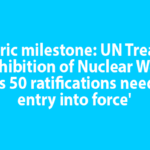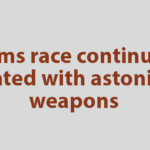The Treaty on the Prohibition of Nuclear Weapons (TPNW) marks a turning point in the long history of the effort to reduce nuclear risks and to eventually eliminate the 13,000 nuclear weapons that remain today, 90 percent of which are held by the United States and Russia. On Oct. 24, Honduras became the 50th country to ratify the treaty, triggering its entry into force 90 days later, on Jan. 22, 2021.
That date will mark the first time since the invention of the atomic bomb that nuclear weapons development, production, possession, use, threat of use, and stationing of another country’s nuclear weapons on a state party’s national territory are all expressly prohibited in a global treaty. The TPNW’s entry into force will arrive almost exactly 75 years after the United Nations General Assembly’s (UNGA’s) adoption, on Jan. 24, 1946, of its very first resolution, Resolution 1 (I), which was to establish a commission to ensure “the elimination from national armaments of atomic weapons and all other major weapons adaptable to mass destruction.”
This milestone is the culmination of a decade-long initiative spearheaded by a group of key non-nuclear weapon states and a global coalition of civil society campaigners working through the International Campaign to Abolish Nuclear Weapons (ICAN), recipient of the Nobel Peace Prize in 2017 for its unflagging efforts. Negotiations on the TPNW were the outgrowth of a series of three conferences on “The Humanitarian Impacts of Nuclear Weapons” held in Norway, Mexico, and Austria between 2013 and 2014. The so-called “Humanitarian Initiative” re-focused attention on the catastrophic dangers to all humanity posed by nuclear weapons and led to the initiation of negotiations on the treaty at the U.N. The talks were completed in July 2017 at the United Nations in New York by a group of more than 120 non-nuclear-weapon states.
The authors of the TPNW, which has the strong support of the International Committee of the Red Cross, argue that because the use of nuclear weapons would violate international humanitarian law, their possession and use must be prohibited. Since the beginning, the major nuclear powers, particularly the United States, Russia, France, and the U.K., have tried to slow the momentum toward the TPNW. They claim their security interests justify the perpetuation of their nuclear deterrence doctrines, which envision the potential use of nuclear weapons on a massive scale.
Filling a Legal Gap
The TPNW effort was designed to fill a “legal gap” in the global nuclear nonproliferation regime regarding the prohibition of nuclear weapons. The 1968 Nonproliferation Treaty (NPT) did not expressly outlaw nuclear weapons, even though their use would be contrary to the rules of international law applicable in armed conflict.
The NPT obligates non-nuclear weapon states to foreswear nuclear weapons, but it recognized the five original nuclear weapon states — the United States, Russia, the United Kingdom, France, and China — already possessed them. Article VI of the NPT obliges all of its 190 States parties to “pursue negotiations in good faith on effective measures relating to cessation of the nuclear arms race at an early date and to nuclear disarmament, and on a treaty on general and complete disarmament under strict and effective international control.” But the NPT does not explicitly ban nuclear weapons, and some nuclear-armed states (India, Israel, and Pakistan) are not members of the NPT. So, while the NPT created the environment and pressure for advances on nuclear disarmament, progress has been intermittent and incomplete.
A Wake-Up Call Amid Rising Risks of Nuclear War
The TPNW arrives at a time when the risks of nuclear war are rising and as the world’s major nuclear armed states are building up their nuclear weapons capabilities. It enters into force at the same time that other key agreements limiting nuclear weapons are being discarded or threatened, and as the major nuclear-armed states are failing to meet their NPT nuclear-disarmament obligations. Public attention, too, is focused on other global threats.
The entry into force of the TPNW is a much-needed wake-up call that has the potential to stimulate further action on disarmament and take us closer to a world without nuclear weapons. By strengthening the international legal structure and political norms against nuclear weapons possession and use, the TPNW further delegitimizes nuclear weapons as instruments of power.
The new treaty also reflects the fact, often forgotten in the United States, that for the majority of the world’s states, nuclear weapons — and policies that threaten their use for any reason — are immoral, dangerous, and unsustainable. The TPNW is, quite deliberately, a powerful challenge to the nuclear deterrence policies of the world’s nine nuclear-armed states, which dangerously assume that military postures and that are designed to threaten the use of nuclear weapons on a massive scale can be perfectly managed, even in a crisis, and will never fail to prevent the outbreak of nuclear war.
This is why the United States and the other nuclear-armed states boycotted the negotiations and why they have, for the most part, been very critical of the agreement.
U.S. Critique Misses the Mark
Last month, U.S. officials sent a message through diplomatic channels to a significant number of states urging them not to join the TPNW. The missive even urged states that have signed and ratified the treaty to withdraw their support. The letter, accompanied by a “non-paper” listing U.S. concerns about the treaty, stated that: “Although we recognize your sovereign right to ratify or accede to the Treaty on the Prohibition of Nuclear Weapons (TPNW), we believe that you have made a strategic error and should withdraw your instrument of ratification or accession.”
The U.S. letter, first reported by the Associated Press, claims that the five original nuclear powers and all members of the NATO alliance “stand unified in our opposition to the potential repercussions” of the treaty. China, however, issued a more conciliatory view in a statement via Twitter on Oct. 24: “China has always been advocating complete prohibition and thorough destruction of nuclear weapons, which is fundamentally in line with purposes of [the treaty]. China will continuously make relentless efforts towards a nuclear-weapon-free world.”
The U.S. paper also claims that “the TPNW is dangerously counterproductive to the [nuclear Nonproliferation Treaty (NPT)].” This argument is without serious merit. TPNW negotiators have repeatedly underscored that the new treaty seeks full complementarity between the NPT and the new agreement.
According to Thomas Hajnoczi, director for disarmament, arms control, and nonproliferation for the Austrian Foreign Ministry, “The TPNW did not create a parallel universe to the traditional one founded on the NPT.” In an article published in The Nonproliferation Review earlier this year, Hajnoczi argues that “on the contrary, it makes the existing universe of legal instruments around the NPT stronger.”
The TPNW’s negotiators note that the pact advances the existing NPT safeguards regime by legally obliging its state parties to keep in place any additional safeguards arrangements they have voluntarily agreed to implement with the International Atomic Energy Agency.
The TPNW also reinforces the international norm against nuclear testing established by the 1996 Comprehensive Nuclear Test Ban Treaty (CTBT), which prohibits “any nuclear weapon test explosion or any other nuclear explosion.” The CTBT has been signed by 184 states.
The TPNW sets forth, for the first time in a nuclear treaty, obligations of assistance to victims of testing and use of nuclear weapons and of environmental remediation of areas affected by testing and use. This reflects the origins of the treaty and the recognition of the unacceptable suffering and devastation that have resulted from the use of nuclear weapons against the people of Hiroshima and Nagasaki and from more than 2,000 nuclear weapon test explosions detonated around the globe, from New Mexico and Nevada and Alaska, across Russia, in Western China, in Kazakhstan, across the South Pacific, in the aboriginal lands in Australia, in Algeria, in South Asia, and until 2017, by North Korea.
Oddly, the U.S. non-paper argues that the pressure that will be exerted by the TPNW to drive nuclear disarmament “disproportionately impacts democracies and democratic alliances” relative to autocratic states like Russia and China, and therefore puts democracies at a disadvantage. According to this strange logic, leaders of democracies should ignore the views of their publics. In fact, history shows that a strength of democratic governments is that they reflect public will. According to a 2020 poll, conducted in the United States July 2–19 for the Chicago Council on Global Affairs, two-thirds (66 percent) of respondents believe that “no country should be allowed to have nuclear weapons,” which is exactly the vision outlined by the TPNW.
Further U.S. efforts to undermine the TPNW are counterproductive and highly divisive. In an Oct. 25 interview with the South African Broadcasting Corporation, South Africa’s ambassador to the U.N. in Geneva, Nozipho Mxakato-Diseko, said: “The U.S. is scared that it cannot justify morally [or] legally the possession of these weapons. They can’t blame us [if] they did not want to negotiate [on the TPNW]. Instead they stood outside the General Assembly picketing, [which is] a ridiculous thing for a member of the Security Council. You negotiate with member states. Leadership is about negotiating.”
By “asking States to un-ratify a treaty,” she said, there is “a danger to the Nonproliferation Treaty. What’s to stop you from un-ratifying the NPT?” We cannot pick and choose the bits of multilateralism that we want.”
ICAN Executive Director Beatrice Fihn said in a statement, “The 50 countries that ratify this Treaty are showing true leadership in setting a new international norm that nuclear weapons are not just immoral but illegal.”
Looking Ahead
Going forward, the United States and the world’s other nuclear-armed states should publicly recognize its arrival as a good faith and constructive effort by the majority of the world’s nations to eliminate the danger of these weapons and build the legal framework for their eventual elimination.
Now that the TPNW exists, all states — whether they are opponents, supporters, skeptics, or undecideds on the treaty — need to learn to live with it responsibly and find creative ways to move forward together to press for progress on their common challenge: preventing nuclear conflict and eventually ridding the world of nuclear weapons.
With the TPNW restoring the navigational settings for the long journey ahead, responsible states can start by agreeing to a common plan of action on nonproliferation and disarmament at the once-every-five-years gathering to review implementation of the NPT in 2021. Measures they could adopt include, but are not limited to, action that would lead to:
- freezing the size of existing nuclear arsenals and fissile material stockpiles;
- a multilateral agreement on no first use of nuclear weapons;
- securing the ratifications needed to bring the CTBT into force;
- reviving the U.S.-Russian disarmament process, beginning with a five-year extension of New Strategic Arms Reduction Treaty;
- verifiable limits leading to the removal of all shorter-range nuclear weapons, including the 160 U.S. tactical nuclear weapons in five European NATO countries, which would enable those states to join the TPNW;
- banning the introduction of new and destabilizing types of nuclear weapons; and concluding legally binding commitments to not target or threaten non-nuclear-weapon states; and
- agreeing that, as Presidents Ronald Reagan and Mikhail Gorbachev did in 1985, “a nuclear war cannot be won and must never be fought.”
Obviously, the new Treaty on the Prohibition of Nuclear Weapons will not reduce the nuclear danger overnight, but it has already changed the conversation. As Martin Luther King said, “The arc of history is long, but it bends toward justice.” Clearly, history doesn’t bend toward justice on its own, and not quickly enough. The TPNW is going to bend history in the direction that all nations say they want, which is the eventual elimination of nuclear weapons.


